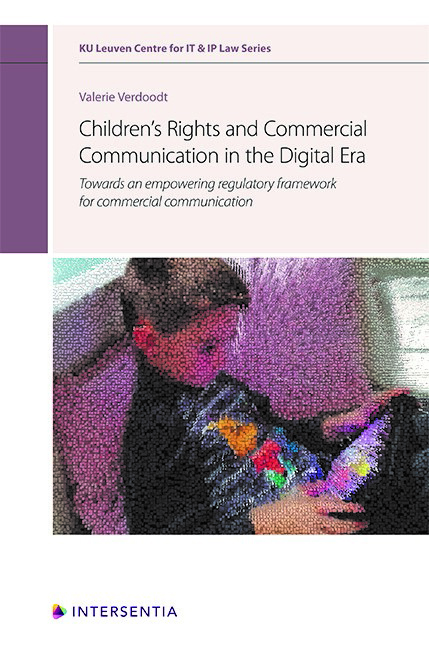 Children's Rights and Commercial Communication in the Digital Era
Children's Rights and Commercial Communication in the Digital Era Book contents
- Frontmatter
- Preface
- Contents
- Abbreviations
- Introduction
- PART I CHILDREN'S RIGHTS AND ADVERTISING LITERACY IN THE DIGITAL ERA
- PART II ASSESSMENT OF THE REGULATORY FRAMEWORK FOR COMMERCIAL COMMUNICATION IN LIGHT OF CHILDREN'S RIGHTS
- PART III ASSESSMENT OF NATIONAL ARIS IN THE AREA OF COMMERCIAL COMMUNICATION
- CONCLUDING REMARKS AND RECOMMENDATIONS FOR THE FUTURE
- Bibliography
- Miscellaneous Endmatter
Chapter II - Conclusions
Published online by Cambridge University Press: 23 July 2020
- Frontmatter
- Preface
- Contents
- Abbreviations
- Introduction
- PART I CHILDREN'S RIGHTS AND ADVERTISING LITERACY IN THE DIGITAL ERA
- PART II ASSESSMENT OF THE REGULATORY FRAMEWORK FOR COMMERCIAL COMMUNICATION IN LIGHT OF CHILDREN'S RIGHTS
- PART III ASSESSMENT OF NATIONAL ARIS IN THE AREA OF COMMERCIAL COMMUNICATION
- CONCLUDING REMARKS AND RECOMMENDATIONS FOR THE FUTURE
- Bibliography
- Miscellaneous Endmatter
Summary
From the above listed research results, a number of final conclusions can be drawn.
THE ROLE OF CHILDREN'S RIGHTS IN REGULATING COMMERCIAL COMMUNICATION. First of all, with regard to the research question at the heart of this book, it can be concluded that children's rights and principles – as interpreted in the specific context of commercial communication in the digital environment – constitute the analytical framework in light of which legislation and alternative regulatory instruments in the area of commercial communication need to be evaluated. This analytical framework requires a balance between empowering children to cope with advertising (i.e. by educating them and providing them with the necessary opportunities to practice their commercial decision-making skills) and protecting them against harmful or misleading advertising (i.e. by recognising the limitations to advertising literacy and providing additional protections). States are responsible for structuring the regulatory framework in such a way that the balance is attained.
SUBSTANTIVE GAPS IN THE EXISTING REGULATORY FRAMEWORK FOR COMMERCIAL COMMUNICATION AIMED AT CHILDREN. From the mapping and evaluation, it can be concluded that such a balance is not achieved in the existing regulatory framework. Several gaps were identified that need to be addressed in order to stabilise the empowerment-protection scales. First, a number of issues which need to be resolved, resulting from the fragmented nature of the regulatory framework, including uncertainties regarding definitions and the scope of application of provisions to new advertising formats were mentioned. In relation to this, the need for a holistic approach to the regulatory framework was discussed. Second, as described, the provisions containing protections for children in the context of commercial communication allocate too much responsibility to children and their parents. In this regard, the need for a deresponsibilisation was underlined. The deresponsibilisation consists of a number of aspects: recognising the limitations of the identification principle and improving its implementation in practice, implementing the data protection framework in light of children's rights and emphasising platform responsibilities. To overcome these signifi cant gaps, several recommendations have been included in the following section.
STRUCTURING OF ARIS IN THE AREA OF COMMERCIAL COMMUNICATION. Finally, with regard to the procedural and organisational elements of ARIs, it was concluded that they need to be structured in accordance with the broader legal framework, including children's procedural rights, but also the benchmarks developed by the advertising industry itself.
- Type
- Chapter
- Information
- Children's Rights and Commercial Communication in the Digital EraTowards an Empowering Regulatory Framework for Commercial Communication, pp. 299 - 300Publisher: IntersentiaPrint publication year: 2020
